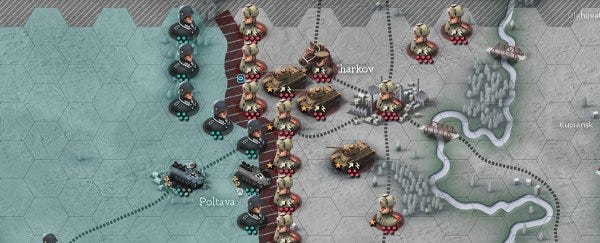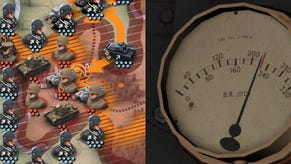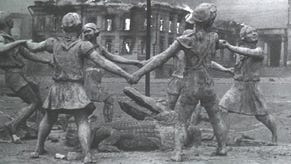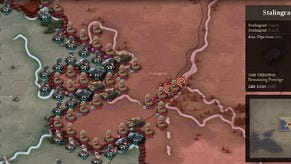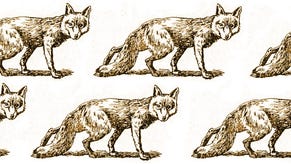Wot I Think: Unity Of Command - Stalingrad Campaign
STALINGLAD!
I'm a shit Nazi, me.
In terms of things that a game can teach about yourself, that's got to be up there somewhere. As my repeated attempts at claiming Stalingrad at a properly blitzekreigian pace mounted up, I realised that I'm not exactly the man Hitler would have rushed into awarding a general's baton. I'm not even sure that Generals have batons. I may be thinking about marching bands. All that marching. I just get confused. That said, Himmler was a shit commander too, and it didn't stop him being giving a bunch of armies to push around the map between doing the activities that don't tend to turn up in accessible wargames about World War Two.
At this point someone has already skipped to the comment thread, and has written an indignant message saying something about the Wehrmacht not being Nazis. That's because I'm baiting you, friend. I'm baiting you. You fell into my trap, much in the same way as I fall into the AI's trap in Unity of Command.
See. Bear with me long enough and, eventually I start talking about the game at hand.
Unity In Command came to my attention in the middle of a Flare Path. It almost doesn't need his prose to sell you on the concept – accessible wargame with hardcore appeal that can actually cross over. The screenshot alone suggests something that's trying to reach a little bit further than its-the-personality-that-counts crowd. And the talk about the game says “Clinical, small scenarios, with a degree of accessibility and purportedly brutal AI”? Hey, baby. No need to conscript me.
Of course, I've played serious WW2 wargames. It's been a while.

I exaggerate, but only slightly.
So I'm coming to this with my eye on it as the great-crossover-wargame-hope. Which is somewhat unfair. This is just a game. It shouldn't have to carry that particular expectation. That, to its credit, Unity of Command doesn't buckle beneath my expectations.
It's a hex-based scenario-centric WW2 wargame, which allows you to approach it at its own pace. With its UI, you can play it badly easily. You select units. You move them around. You move them into enemy units. And lo! Within a few turns you realise you're doing it. You're actually doing it. You're playing a wargame! Badly.
And then you start picking stuff up. The full limit of my tactical knowledge is a vague recollection that a land war in Asia is a bad idea – but when the entire concept of the game is about a land war in Asia, I'm kind of left adrift. But the basics start seeping in. Tanks generally crush stuff. Hungarians are generally crushed by stuff. Attacking across a river ends badly. Having your supply lines cut is disastrous... actually, let's come back to supply lines later.
At this point you may decide it's time to not actually just read the manual, but to try to understand it. And you're starting to think about how tanks actually crush stuff, which isn't solely related to their enormous attack, but their fundamental capabilities as tanks. Give a couple of tanks to an infantry unit, and you'll blunt the worst of it. Choose the right terrain to blunt it some more. Realise the difference between artillery supported units and Katyusha supported ones (The former are towed, which means that if they move, they lose their artillery bonus if they attack at the end... but are ready to counter enemies on their turn. The latter's rocket-heavy artillery support can move and attack, at the expense of slightly less punch, making them more suitable for swifter assaults. Also, they have a better name). You start to realise how you can actually pull of a river crossing. You realise how you can best position your most powerful units to maximise their chances over over-running several units in a single turn. You start thinking of useful things for Hungarians to do, other than act as improvised paint for tank treads...
You start playing a wargame. And that's wonderful. It's a neat, interlocking matrix of possibilities.
And it all rests on supplies. Bar the most experienced units, lacking a clear route to the nearest supply base means they don't get resupplied. Not having it for two turns, and they can't attack. Not having it for three turns, and you may as well be Hungarians. Which leads to a game which rewards the grand encircling manouveres of World War 2. And there's few things which punish an over-optimistic attack than cutting off their resupply, even for a turn. A tank with seven units uses two of its supplies in a previous turn? It doesn't get it replenished? Well, before it even tries anything, the next turn it's only going to be on 5/7th strength. Which immediately removes the momentum of your attacks, which brings the whole house of cards crashing down. An oversight in protecting your supply can undermine your whole game, forcing you to waste turns while cursing, cursing all the while.
Of course, it's worse when you realise the power of supplies – which you will realise early, they're that fundamental - and start trying to do encircling. And you're so incompetent, its primary effect is just weakening your defences enough to let them simultaneously cut off your supply lines. And then everyone cries.
Except the AI. It looks at your with its steely, robotic gaze and snorts, looks at your lines, finds the bit where you're weakest, and punches through. See this?
That's the AI, being a bastard.
So I play the scenario again, reinforce that bit with anti-tank, twiddle a bit more, try to encircle him and...
That's the AI, being a bastard.
And to (movie) quote the Tim Stone of WW2, A Magnificent bastard.
So - accessible yet deep, attractive and with an AI which teaches you the core of the game by beating you around the head. Scenario play, two campaigns and even a tiny bit of multiplayer (hotseat or internet play, on a single map). It's a hell of a wargame. But for all its charms, it's not going to be the one which drags in a (PC) mass audience into a scenario-based hex-map wargame. And, perhaps somewhat sadly, it's in areas where the game's most interesting that it's going to lose people.
The big one is its campaign structure. While you can play any scenario individually, they're chained into a campaign, with your degree of the success in a mission determining whether you get to play the next one or not. The key thing being “degree of your success”. There's bottlenecks in the campaign where unless you manage to get the top level of victory, you're barred from progressing through the campaign. It's just fundamentally strange to win a battle and then told it's game over with 3/7 scenarios played. And while the structure is demanding and compulsive, making you constantly push for the big win, it doesn't stop it being genuinely alienating. Much like the Kings of convenience, all too often you find yourself winning the battle, but losing the war.
The second problem is a small one, but its impact is multiplied by the unforgiving campaign structure. There's no undo function. While I understand its lack for undoing battles – because there's a random factor there and it'd just be an excuse to game the system – for moves it's painful. Clicking and moving around the map, it's fairly likely you're going to move a unit to the wrong place every game or two. And when the scenarios are balanced so that the much-lusted-after decisive victory often does hang off a single move, this can flip a victory to a loss. Oh – and while the game saves when you leave a scenario, there's no actual save, meaning that you have to replay the whole level to get to the place of the error. If you're tough, you swallow that when it's part of the game, and your tactics are defeated – and they're the correct length to replay too. When it's the equivalent of playing a boardgame with someone who shouts “you took your fingers off the piece”, that's a tad more grating.
The third problem is a softer psychological one, which makes the game harder than it ought to be. As well as earning points from victories, you earn prestige. Prestige can be spent in missions on reinforcements, plumping up units or adding a handy tank or two to a formation. Which is neat. The problem is that Prestige both builds up across games and that also acts as a score bonus. Both make the gamer want to stockpile as much as they can. Because clearly the mission is completable without spending any, so you don't. You will tend to only spend prestige when you're sick with being beaten on a level to press on through. When the reinforcement system is neat and adds a lot of options, that the design actively discourages you using it and makes finally submitting to touching it taste bitter, that's a mistake.
In some scenarios you're actually given a few free reinforcements, which makes the error clearer. Seeing that you've got three anti-tank guns available, and choosing where you need to prop up your line is a meaningful and compulsive tactical decision – and a suggestion of a way that the prestige system could have improved the game.
I think the reinforcements is the one area of the design I'd question outright. For the rest, it's mainly things which limit the game's wider appeal. I say “limit” rather than remove. Because even though it's not the game that takes the pop appeal of Advance Wars and marries it to the niche appeal of the inside of Tim Stone's head, this is a damn sight more accessible almost anything else. PC-gaming everyman Alec would like it. I suspect Adam has already played it, and I equally suspect he likes it. But I suspect its poise isn't enough to get the Jims of the world on board.
Clearly, Walker is about as much of a lost cause as my latest Hungarian-lead offensive.
